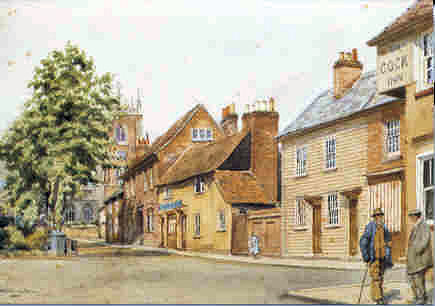Following an email from Colin relating to the Anscombe family of Harpenden I decided to update the Anscombe page with a link to Mrs Pamela Anscombe's funeral, which lists relatives who were still living. The page also included details of a fire at the Anscombe's shop and other local news which I have copied below.
HARPENDEN.
Messrs. Anscombe wish to thank all those who rendered each useful assistance at the recent fire on their premises.
St. George's School. — On Sunday evening at evensong a special sermon was preached in the chapel of this school by the Rev. B. W. Harris, in aid of the Home Missions in East London. The offertory was also devoted to the same object.
Young Women’s Guild. — The members of the above guild held their quarterly tea and meeting at the rectory Monday. Various games were indulged in ; the members afterwards attending a service in the parish church, when address was given by the Rector.
Accident to little Girl.— On Friday afternoon a little girl named Puter, of Luton, met with a somewhat serious accident whilst playing on the large roller near the cricket ground. She was running down the shaft, and falling on to some ironwork gashed her knee. Dr. Wilson dressed and stitched np the wound.
Wesleyan Chapel. — This chapel was well filled on Sunday evening, when a sermon was preached by Mr. M. White, a coloured student of Richmond College. Mr. White also gave an address to the scholars in the afternoon. He is now training to go back as missionary among his own people.
Congregational Chapel. — The anniversary services of this chapel were held Wednesday. A public tea was provided at which good company assembled. Two excellent sermons were preached afternoon and evening by the Rev. J. Brown, D.D., of Bedford (Chairman of the Congregational Union of England and Wales), at which there were large congregations.
Outbreak of Fire.—On Saturday night, about 12.30, an outbreak of fire in some sheds on the premises at Messrs. Anscombe and Son's was simultaneously discovered by several persons. Mr. W. H. Anscombe, who is captain of the Fire Brigade, was quickly on the spot, and was shortly afterwards followed by the other members of the Brigade. It was then found that a shed, utilised as a storehouse for empties, with some chairs and fixtures, was in full flames. It was impossible to save this building, and the efforts of the Brigade were then directed to preventing the fire spreading to adjoining stables and premises. The structure was composed of wooden walls, and was about 30 feet long by 12 feet wide and 16 feet high, with galvanised iron roof. Messrs. Anscombe are insured in the Union Office, and the damage is estimated at about £30.
Death of Mrs. Anscombe, Jun. — The death of Mrs. Allen Anscombe. jun., occurred on Thursday in last week. The deceased lady, who was the daughter of Mr. Rothwell, had been married about eight years, and leaves three sons. She had been suffering for about eleven months from a cancer of the tongue and throat, for which she was attended by Dr. Blake. At that time an operation was performed upon her at King's College by Mr. Heath. It was hoped that this would prove effectual, but although it afforded temporary relief, it was necessary that other minor operations should be undergone. Notwithstanding the treatment and the supreme efforts used the cancer gradually increased, and eventually terminated fatally. Mrs. Anscombe bore the trouble with great fortitude and courage. For some time prior to her marriage the deceased lady took an active interest in the Congregational Chapel at Harpenden. The funeral took place onTuesday afternoon at Harpenden Church, a large number of the inhabitants of the village, and personal friends, together with relatives, being present. The service was conducted by the Rev. E. T. Vaughan, rector. The mourners were — Mr. Allen Anscombe, jun., and Mr. W. B. Bothwell, Mr. and Mrs. Mr. W. H. Anscombe and Mrs. Mallett, Mr. and Mrs. Anscombe. Mr. B. Anscombe and Miss Anscombe. Mr. A. E. Ansoombe and Miss 8. F. Anscombe, Rev. W. R. Price and Miss Ashworth. The employes of Messrs. Anscombe also followed. The funeral arrangements were carried oat by Mr. Irons, the coffin being of oak with burnished brass plates. The inscription was: Pamela Ansoombe, died 25th June, 1831, aged 36 years.” A large number of beautiful wreaths sent by relatives and friends completely covered the coffin. Among them were the following : from W.H. Ansoombe: “From brothers and sisters,” A.E.A., E.A., E.M.A., and S.F.A.; from W. E. Rothwell; “With loving sympathy.” from E. M. Rothwell; With deepest sympathy. ’ Mr. and Mrs. Frear, sen., and the Misses Frear; "With respects,” from Lizzie and Emily: With deepest sympathy,” from Mr. and Mrs. Winter: from Mrs. Claridge ; “With deepest sympathy.” from Mr. and Mrs. Willmott; "With sympathy,” from Mr. and Mrs. Simons and all at Cell Park-farm: "In token of our esteem and sympathy” from the assistants; “With sincere respect and sympathy,” from the workroom; “In loving memory," from Eliza and Harriett Walsh.












































